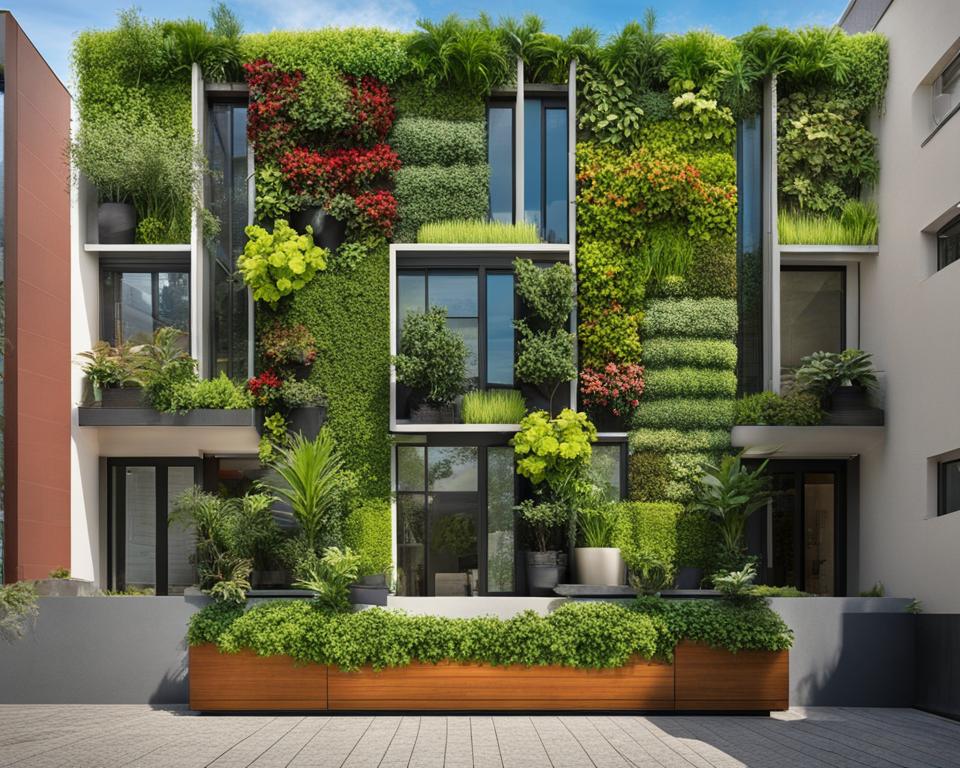Delving into the world of vertical gardening, you uncover an artful integration of nature and design that transcends traditional horticulture. Whether you’re an urban dweller with a compact balcony or a homeowner looking to enhance your living space, vertical gardening offers a broad range of possibilities. This innovative approach not only makes efficient use of limited space but also brings a dynamic aesthetic element to both indoor and outdoor environments.
Imagine transforming a bland wall into a lush cascade of greenery or cultivating a vertical herb garden within arm’s reach in your kitchen. As you embrace these vertical gardening ideas, you’ll also discover valuable vertical gardening tips that simplify the cultivation of your own thriving green space.
Transform areas with minimal square footage into verdant retreats by inviting nature to climb upwards, defying the pull of gravity and showcasing the vibrant tapestry of life. Embrace this harmonious blend of functionality, beauty, and environmental stewardship as you explore what is vertical gardening in depth.
Key Takeaways
- Discover what vertical gardening is and how it maximizes limited space.
- Unearth creative vertical gardening ideas to beautify both indoor and outdoor spaces.
- Learn essential vertical gardening tips that ensure the success of your garden.
- See vertical gardening as a versatile solution for urban settings and small areas.
- Recognize vertical gardening’s role in improving air quality and aesthetic appeal.
- Understand how vertical gardens provide accessible gardening opportunities for everyone.
Introduction to Vertical Garden Concepts
Embracing the upward climb in gardening, vertical gardening fulfills both aesthetic and practical desires in urban and residential landscapes. This innovative approach facilitates plant growth on a vertical plane, demonstrating not only a celebration of nature’s flexibility but also a smart solution to the constraints of modern living spaces. In this exploration of vertical gardens, we delve into the origins of this technique and why it has become so appealing in contemporary horticulture.
Definition and History of Vertical Gardening
Vertical gardening, in essence, refers to the cultivation of plants using vertically oriented structures, such as panels or trellises. These supports allow plants to grow upward rather than sprawling horizontally, which maximizes space and can also serve as creative décor. Historically rooted in the practice of guiding climbing plants like ivy up a fence, today’s vertical gardening systems have evolved into sophisticated structures capable of hosting a diverse array of flora. Renowned figures like Patrick Blanc have revolutionized this field with the concept of ‘living walls’ that act as organic tapestries in urban environments.
Why Vertical Gardens are Gaining Popularity
Vertical gardening structures have witnessed a surge in popularity due to their versatility, especially in densely populated urban areas where horizontal gardening space is at a premium. Not only do these systems furnish small apartments and compact outdoor areas with greenery, but they also offer improved air circulation and a slice of serenity amid the urban hustle. Discovering how to start vertical gardening can offer an enriching experience, yielding benefits that span beyond simple aesthetics, catering to the well-being of city dwellers.
Whether you’re charmed by the idea of a green corner in your kitchen or considering a large-scale exterior installation, vertical gardens inspire a new perspective on how we integrate the natural world into our everyday lives. From small-scale DIY projects to elaborate installations, the transformation of space through vertical gardens is a testament to innovation and a growing green ethos among modern cityscapes.
What is Vertical Gardening?
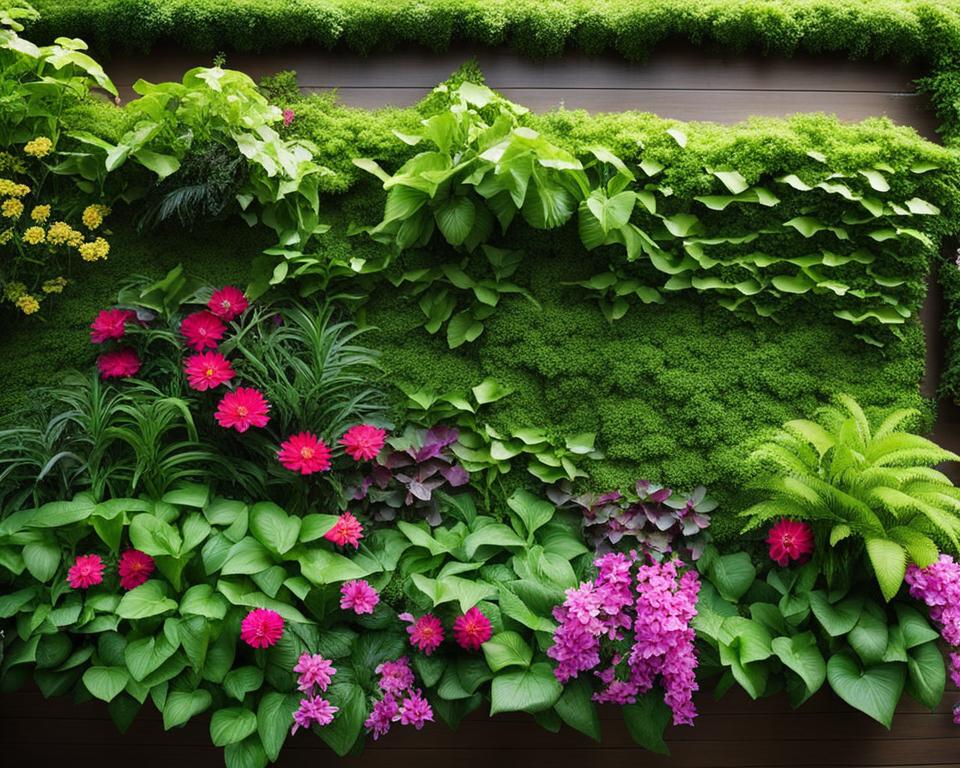
Vertical gardening is a method that transcends the traditional confines of planting in the horizontal plane by employing various vertical gardening techniques to grow plants along upright surfaces. You may wonder, what is vertical gardening exactly? Well, it’s an ingenious way to bring a slice of nature into any environment, regardless of the amount of ground space available.
With roots in ancient civilizations, today’s vertical gardens make use of modular panels, towers, and a range of structures to enable plants to rise above the ground. This approach is not only space saving but also serves as an elegant solution to incorporate greenery in both personal and public realms. Imagine your kitchen wall sprouting with fresh herbs or a large blank wall in a corporate lobby transformed into a lush tapestry of vertical gardening plants.
One key advantage of vertical gardens is their versatility. They can be designed to fit just about any vertical surface, freeing up precious floor space while adding visual interest to any space. From flowering vines that bring color and fragrance to your balcony to hearty vegetables that offer a fresh addition to your dinner table, the possibilities with a vertical garden are nearly endless.
So, whether you want to add a dash of green to a small apartment or create a focal point in a large office space, engaging in vertical gardening could be your next great venture into cultivating new growth, both literally and aesthetically.
- Maximize limited space with innovative vertical structures
- Grow a variety of ornamental and edible plants
- Introduce natural beauty into urban and corporate settings
As you explore the dynamic world of vertical gardens, you’ll discover that they not only enhance your living space but also contribute to environmental well-being, offering a fresh perspective on the art and science of gardening.
Benefits of Growing Upwards
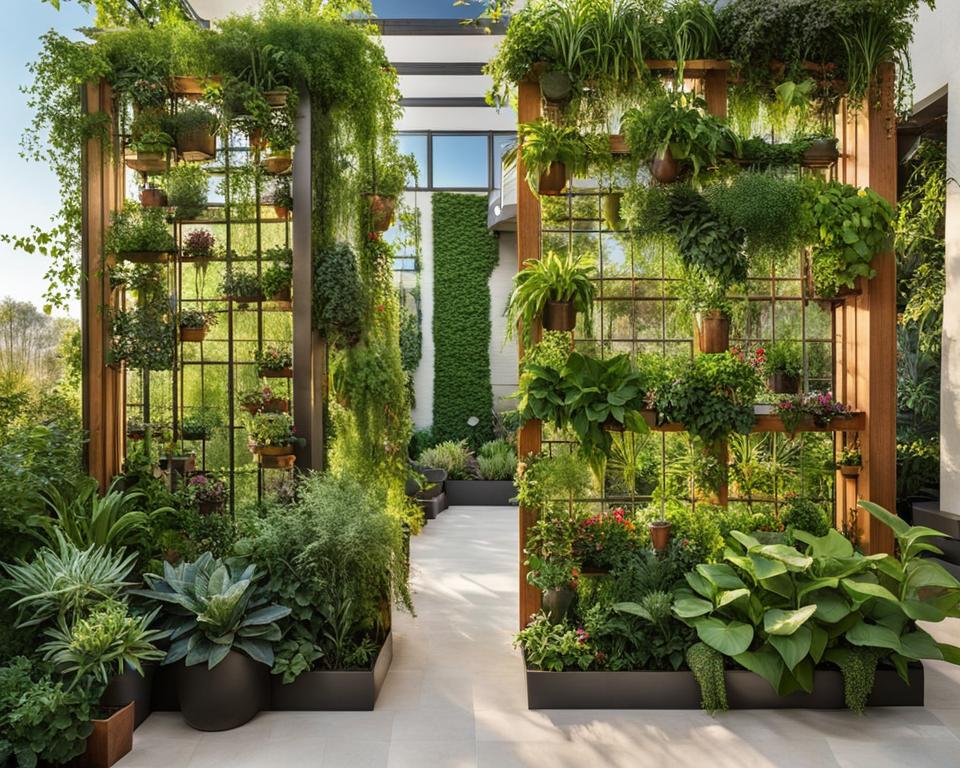
When you embrace vertical gardening, you’re not just planting – you’re innovating in your very own urban oasis. There are countless advantages to this approach, which is why it’s steadily gaining momentum among city dwellers and enthusiasts of sustainable living. Whether you’re looking to beautify your balcony or cultivate a lush interior garden, vertical gardening offers a versatile palette of green solutions tailored for every space, big or small.
Space Efficiency and Urban Adaptability
One of the key benefits of vertical gardening is its remarkable ability to optimize limited space. If you’re living in an apartment or a home with a small footprint, vertical gardens unlock new possibilities. They allow you to grow plants upwards on walls or trellises, turning areas previously unsuitable for traditional gardening into productive and pleasant green spaces. Perfect for balconies, patios, or indoor settings, vertical gardens adapt seamlessly to the spatial constraints of urban environments, making them ideal for bringing a touch of nature to the concrete jungle.
Enhancements in Aesthetic Appeal and Air Quality
Vertical gardens aren’t just practical; they’re a visually striking addition to any space. With a vast array of vertical gardening ideas at your disposal, you can transform bland walls into dynamic, living works of art, increasing the aesthetic value of your environment. Moreover, these vertical ecosystems enhance air quality by purifying the air around them, which can be particularly beneficial inside your home during those dry winter months when air quality tends to wane.
Accessibility for Diverse Gardeners
Traditional gardening can be challenging and sometimes inaccessible for those with physical limitations. Vertical gardening bridges this gap, providing a more comfortable and manageable way to enjoy gardening. By elevating the garden to a more accessible height, individuals with disabilities or those facing difficulties with bending and kneeling can engage in the gardening experience with ease.
- Improved use of limited urban spaces
- Indoor and outdoor adaptability
- Visual transformation of living spaces
- Better air quality in the home or workspace
- Inclusive for gardeners of all abilities
Now that you’re acquainted with some of the compelling reasons to consider vertical gardens, it’s time to explore various vertical gardening ideas that suit your space and style. The beauty of this method lies in its flexibility, providing a plethora of options to personalize and create green areas that resonate with your aesthetic and functional needs.
Choosing the Right Vertical Gardening System
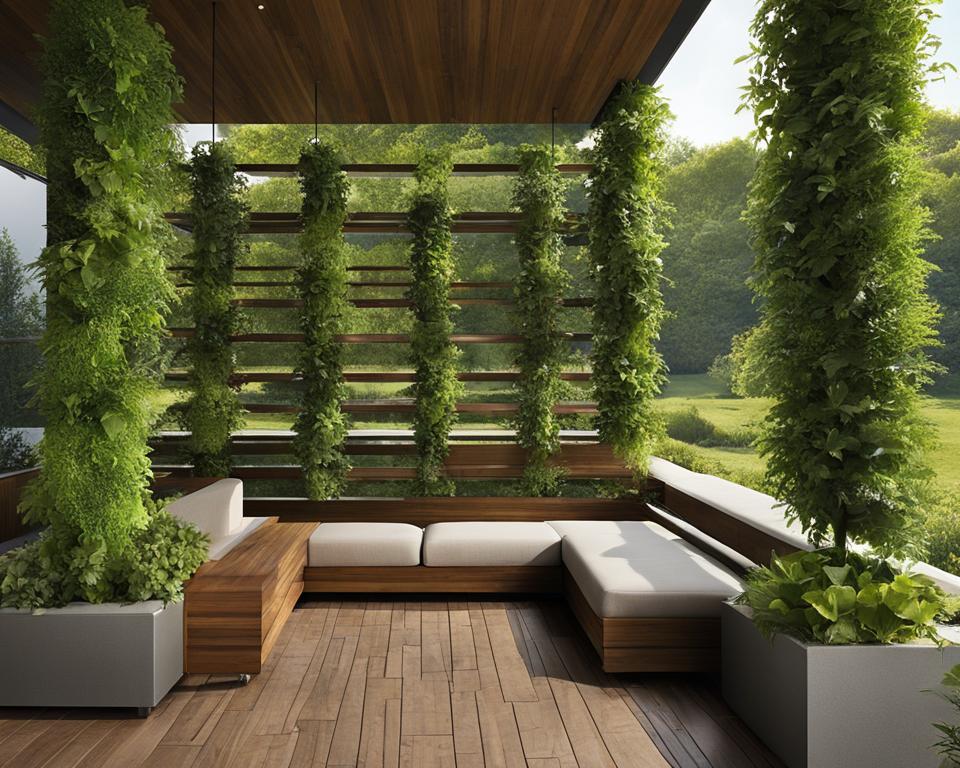
Embarking on your vertical gardening journey begins with understanding the various systems available. The approach you select must harmonize with your space limitations, exposure conditions, and aesthetic preferences. It’s essential to acquaint yourself with the diverse structures and to choose one that will ensure the vitality and sustainability of your garden.
Understanding Various Vertical Garden Structures
Vertical gardening systems are the backbone of your growing space. They range from simple trellises to intricate modular units, allowing for a gardening solution that can be tailored to fit any environment. Before diving into the world of vertical gardening, acquaint yourself with the types of structures available and how they can be utilized to create a thriving garden in your home or workplace
Green Walls and Modular Systems
Green walls are the pinnacle of vertical gardening, offering an eye-catching, lush landscape that can be adapted to both indoor and outdoor settings. These systems can host an assortment of plants and are equipped with technology to control water and nutrients. Modular systems also provide excellent flexibility, making them a smart choice for anyone wondering how to start vertical gardening. By combining design creativity with practical function, these systems form an impressive cornerstone for green spaces in urban areas.
The Importance of a Supporting Framework
Finding the right framework is a critical step in creating a durable vertical garden. The materials, from sturdy metal to resilient plastic, must be evaluated not only for their aesthetic value but also for their structural qualities and resistance to the elements. The strength and support of the frame will determine the longevity of your vertical garden and impact its capacity to grow diverse plant species effectively.
| Structure Type | Best For | Considerations |
|---|---|---|
| Trellises | Climbing plants, small spaces | Easy to install, suitable for beginner gardeners |
| Green Walls | Indoor air quality, aesthetic appeal | Requires more investment and care, ideal for expansive wall surfaces |
| Modular Systems | Flexible design, adjustable layouts | Modular nature allows for easy expansion and customization |
Vertical Gardening Techniques and Tips
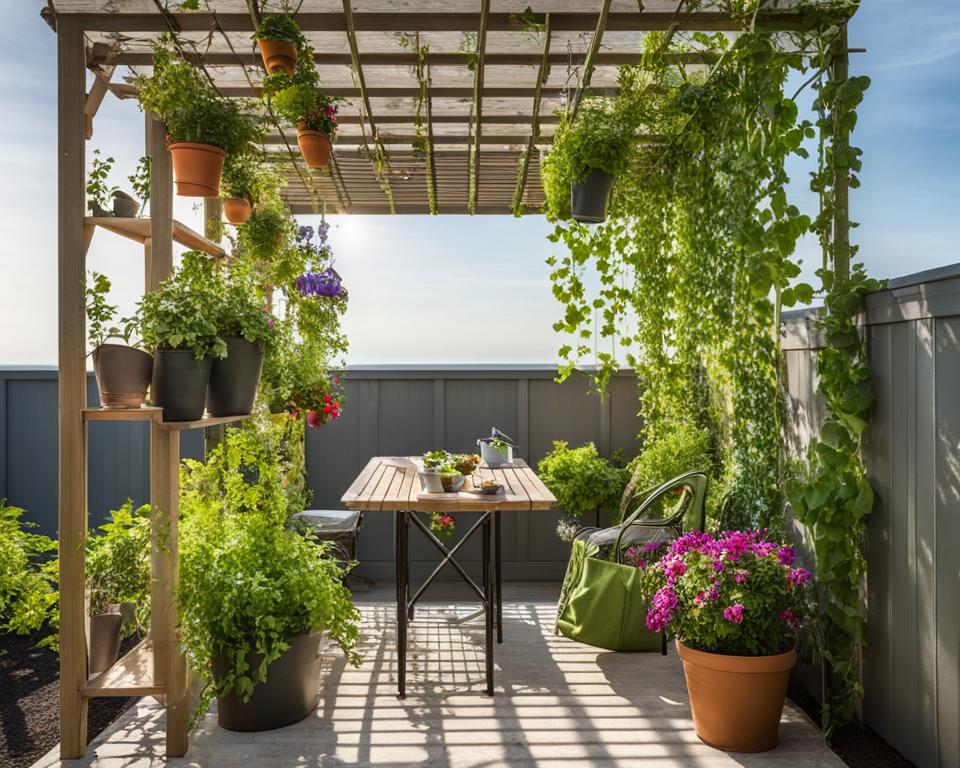
Embarking on the journey of vertical gardening can be both exciting and fulfilling. If you’re wondering how to start vertical gardening, it’s essential to first establish a solid base. Anchor your structures securely, considering the full weight of the plants when fully grown. Shadows cast by vertical elements could influence what type of plants you might want to grow nearby due to varying light exposure.
For those seeking creative and efficient vertical gardening ideas, think about the types of climbers that require less manual training, such as ivies or certain types of jasmine, which are self-clinging and can make maintenance easier. However, plants like sweet peas will need your help to twine around supports.
It’s crucial to be aware that plants in a vertical garden will have different needs compared to those in traditional gardens. They may face more extreme conditions such as increased exposure to light and wind. This means a diligent watering and fertilizing schedule is essential for their survival. Here’s a handy guide with vertical gardening tips to help you maintain a vibrant vertical oasis:
- Check plant moisture regularly—vertical garden plants may dry out faster than their ground-grown counterparts.
- Be mindful of nutrient needs, as vertical gardens often require more frequent feeding.
- Pruning is not just for aesthetics—it helps prevent disease and promotes healthy growth.
Dusting your plants will keep them breathing easy, and don’t hesitate to replace any that aren’t thriving. It’s part of the natural cycle and gives you an opportunity to try new species that might perform better in your unique garden conditions.
Remember, a flourishing vertical garden is a living tapestry that evolves with time. Your care and attention will make all the difference.
Whether you are seeking a lush backdrop for your outdoor patio or hoping to cultivate a slice of nature inside your urban home, vertical gardening is a smart, space-saving solution that brings the joy of gardening to new heights.
Selecting the Appropriate Plants for Your Vertical Garden
As you delve into the world of vertical gardening, the plants you choose become the essential palette for your living masterpiece. Whether seeking to adorn your vertical space with vibrant hues or cultivate your own fresh produce, the selection of vertical gardening plants will define the character and functionality of your garden.
Plants for Beauty: Ornamentals and Flowers
Enrich your vertical retreat with a cascade of color and texture by integrating an array of vertical gardening flowers. The ornamental plant choices such as the black-eyed Susan vine will drape your vertical spaces in a veil of golden blooms, while clematis gifts a seasonal display of colorful petals. For the striking appeal of height and floral drama, the climbing hydrangea could be an unmatched centerpiece.
Edible and Aromatic Options: Fruits, Vegetables, and Herbs
No vertical garden is complete without considering the inclusion of vertical gardening vegetables and herbs. Not only do they infuse your walls with a myriad of textures and shades of green, but they also offer the practical benefit of fresh, home-grown produce. Vegetables such as snap peas, cherry tomatoes, and pole beans are perfect for vertical growth, and they’re as delightful to pluck as they are to plate.
Choosing Shade or Sun-Loving Varieties
Your vertical garden’s location will largely determine the right mix of sun-loving and shade-adapting species. When sunlight caresses your vertical haven, sun-loving plants like nasturtiums will flourish with minimal care. For more dimly lit areas, the chocolate vine and Dutchman’s pipe are excellent choices for their resilience in lower light conditions, ensuring lush, verdant growth throughout your vertical landscape.
| Plant | Type | Light Requirements | Benefits |
|---|---|---|---|
| Black-eyed Susan Vine | Flower | Full Sun to Part Shade | Colorful Blooms |
| Clematis | Flower | Full Sun to Part Shade | Vibrant Petals, Height |
| Climbing Hydrangea | Flower | Part Shade | Large, Showy Flowers |
| Snap Peas | Vegetable | Full Sun | Edible Pods |
| Cherry Tomatoes | Vegetable | Full Sun | Sweet Fruit, Easy to Grow |
| Pole Beans | Vegetable | Full Sun | Vertical Growth, Edible |
| Nasturtiums | Edible Flower | Full Sun | Peppery Flavor, Vibrant Color |
| Chocolate Vine | Flower | Full Sun to Full Shade | Adaptable, Fragrant |
| Dutchman’s Pipe | Flower | Full Shade to Part Shade | Unique Shape, Shade Tolerant |
Vertical Gardening for Small Spaces
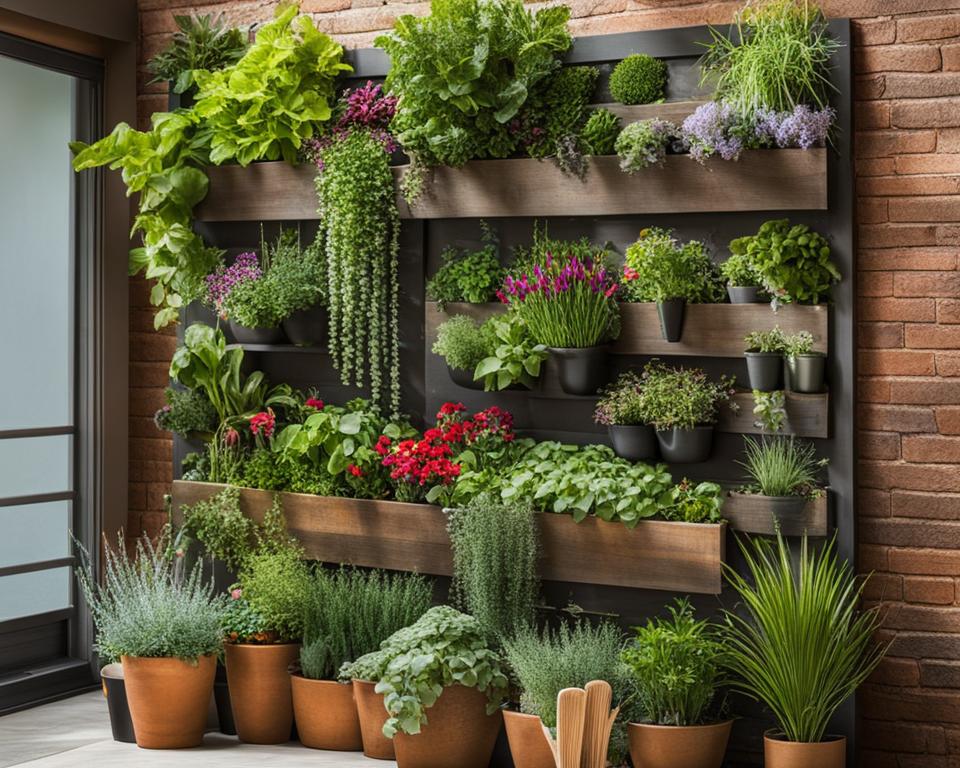
Don’t let the confines of a smaller living area deter you from cultivating a beautiful garden. Vertical gardening for small spaces provides innovative solutions that turn any miniature area into a green sanctuary. Understanding how to maximize these areas will not only add a touch of nature to your home but also reap the various benefits of vertical gardening.
Maximizing Limited Areas: Balconies, Patios, and Indoors
Take your balconies and patios from bare to lush with simple vertical gardening techniques. Installing window-mounted trellises brings a cascading green curtain to life that can offer privacy while beautifying your outdoor space. Convert an empty indoor wall into a living art display that infuses your home with freshness and vibrancy, adding to the much sought-after benefits of vertical gardening. It’s astonishing how a vertically-oriented approach can transform even the most cramped spaces into productive ecosystems.
Creative Ideas for Compact Gardening
Engage your creativity by utilizing unconventional items for your compact garden. Pallet planters give a rustic charm to your greenery, while repurposed hanging organizers serve as innovative, space-saving homes for your favorite herbs. For the DIY enthusiasts, creating a tower garden allows for an array of vertical gardening ideas, from aromatic herbs to a vertical salad bar. Embrace these inventive gardening methods and watch your limited space flourish with life.
Every square inch of your space is a potential growing spot. With these strategies and a touch of imagination, vertical gardening for small spaces not only amplifies the aesthetics of your home but also contributes to a healthier environment. Enjoy the process of designing your unique vertical garden, and relish in the lush foliage and blooms that accompany urban gardening ingenuity.
Maintenance and Care for Vertical Gardens
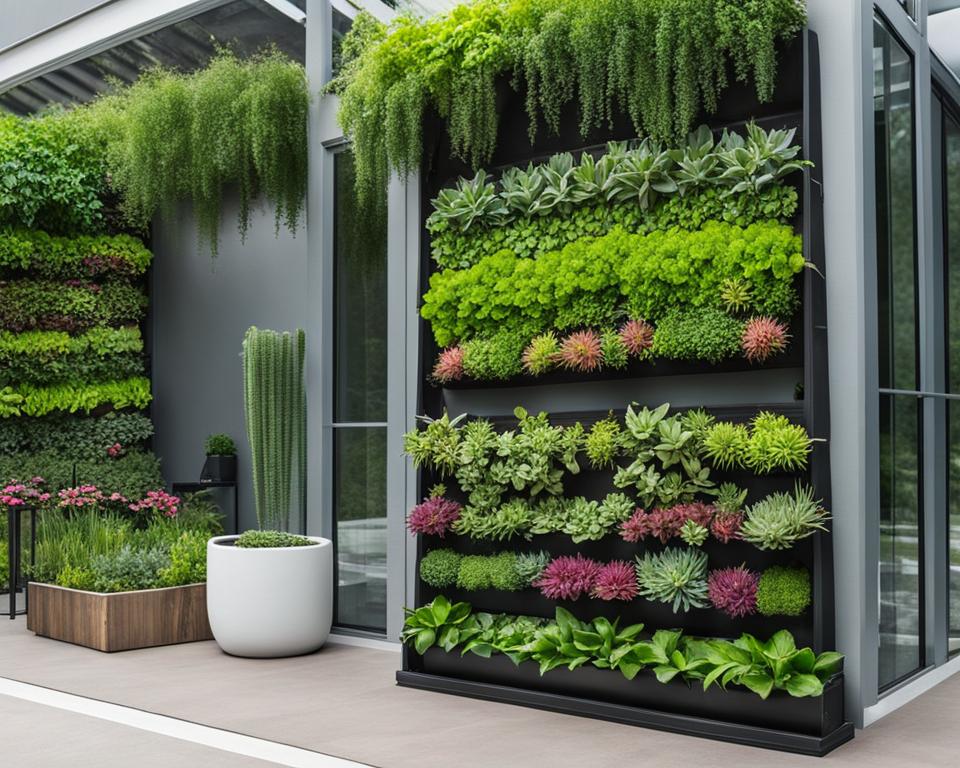
Maintaining your vertical garden ensures that it remains a vibrant and productive space. Adequate maintenance revolves around three core aspects: effective irrigation practices, diligent nutrient management, and seasonal upkeeping. By integrating vertical gardening techniques into each of these aspects, you can promote a thriving garden, no matter the scale.
Irrigation Solutions for Vertical Setups
Due to their unique orientation, vertical gardening systems require distinct watering solutions to keep plants hydrated without water wastage. Drip irrigation, with its targeted delivery, is an economical choice, ensuring that each plant receives the moisture it needs. Likewise, self-watering planters can minimize the hassle of frequent watering, a boon for busy gardeners.
Nutrient Management and Plant Health
In the confined soil spaces of vertical gardens, your plants rely on you for their nutritional needs. Incorporation of a high-quality soil mix, possibly one crafted for container gardening, can significantly bolster drainage and nutrient intake. Furthermore, the regular application of compost or time-release fertilizers can support robust plant growth.
Seasonal Adjustments and Upkeeping Activities
As the seasons change, so too should your approach to garden maintenance. This includes relocating plants to accommodate changing sunlight patterns or implementing shade to protect them from harsh summer rays. Regular pruning, dusting, and disease monitoring form the linchpin of garden health, ensuring your vertical oasis remains lush and productive year-round.
| Seasonal Task | Spring/Summer | Fall/Winter |
|---|---|---|
| Watering | Increase frequency due to higher temperatures | Reduce frequency as plants enter a dormant phase |
| Nutrition | Supplement with balanced, liquid fertilizers for growth | Switch to phosphorus-rich feeds to support root development |
| Pruning | Trim to promote bushier growth and manage space | Prune dead or dying foliage to prepare for new growth |
| Sunlight Management | Adjust positioning to maximize light exposure | Introduce grow lights if natural light is insufficient |
| Pest Control | Monitor for pests that thrive in warm weather | Keep an eye out for indoor pests that seek shelter |
Conclusion
Embracing the innovative concept of vertical gardening offers you a unique opportunity to integrate the beauty of nature into your everyday environments. This approach channels the myriad benefits of vertical gardening into spatially challenged and design-conscious landscapes alike, repurposing vertical space that would otherwise remain underutilized. By capitalizing on creative vertical structures, you can transform bland walls into lush, living tapestries that not only optimize available space but also substantially elevate the aesthetic value of any setting.
Armed with a wealth of vertical gardening ideas, you are poised to tailor your green sanctuary to reflect personal tastes and suit environmental conditions. Whether you choose to cultivate a medley of vibrant flowers, a selection of culinary herbs, or a vertical vegetable patch, success hinges on selecting the right system and plants that thrive within the bounds of their new vertical realm. Coupled with diligent care and vertical gardening tips such as proper irrigation and nutrient maintenance, your vertical garden is destined to become a cornerstone of your home or workplace, offering a daily dose of tranquility and connection to the natural world.
The versatility of vertical gardens ensures that anyone, regardless of the size of their living space, can engage in this gardening method. From sprawling backyards to cozy apartment terraces, these gardens are adaptable, easily accessible, and serve as an innovative solution for plant enthusiasts in the modern age. The result is not just a delightful visual experience but also a meaningful contribution to environmental and personal well-being, reinforcing the sustainable mantra of building upwards and greening our urban landscapes.
FAQ
What Is Vertical Gardening?
Vertical gardening is the art and science of growing plants on a vertically suspended panel or structure instead of in the traditional, horizontal manner. This method uses upright surfaces such as trellises, walls, or towers to support the plants, making it ideal for small spaces and urban environments.
Can You Share Some Vertical Gardening Ideas?
Yes, there are numerous ideas for vertical gardens, ranging from wall-mounted planters and hanging baskets to using old pallets or constructing your own plant towers. Green walls and living paintings are other sophisticated options that can serve as both decor and functional plant space.
What Are Some Tips for Starting a Vertical Garden?
When starting a vertical garden, selecting the right system for your space, such as trellises or modular panels, is crucial. Choose plants suited for vertical growth and consider the amount of sunlight and water they’ll need. Use a high-quality soil mix specifically designed for containers and ensure your system has adequate support and a reliable irrigation method.
What Are the Benefits of Vertical Gardening?
Vertical gardening optimizes limited space, especially in urban areas, improves air quality and circulation, adds aesthetic value to any setting, and allows for easier gardening access for people with mobility issues. It’s also a creative way to cover unsightly walls or fences.
What Vertical Gardening Systems Are Available?
There are a variety of systems available, including traditional trellises, self-contained vertical wall planters, pocket gardens, and modular systems. Each system has advantages that cater to different plants, space arrangements, and gardener preferences.
What Are the Different Vertical Gardening Techniques?
Techniques for vertical gardening include training plants to climb structures, using soil-less mediums with hydroponic systems, creating living walls with interwoven plants, and choosing the proper system that provides balanced sunlight and water distribution for plant growth.
What Plants Can Be Used in Vertical Gardening?
A wide range of plants are suitable for vertical gardening, from flowering vines like clematis and morning glory to edible plants like tomatoes, herbs, and strawberries. It’s important to choose plants based on your garden’s sun exposure and climate.
How Do You Create a Vertical Garden in a Small Space?
Maximizing a small space for a vertical garden can be done by installing wall planters, employing hanging pots, using balcony rail planters, and utilizing stackable or pocket planters that can be easily hung or attached to a vertical surface.
What Are Some Creative Vertical Gardening Ideas for Compact Spaces?
For compact spaces, imaginative ideas include vertical pallet gardens, utilizing over-the-door shoe organizers for small plants and herbs, mounting gutter gardens on a wall, or employing magnetic plant containers for fridge or other metallic surfaces.
How Should a Vertical Garden Be Maintained?
Regular maintenance of a vertical garden involves consistent watering (possibly through a drip irrigation system), pruning, monitoring for pests, replenishing nutrients with fertilizers or compost, and making seasonal adjustments for plant health and productivity.
What Are Some Irrigation Solutions for Vertical Gardening Setups?
Drip irrigation is a common solution that provides gradual water to plants at their base, reducing waste and keeping foliage dry. Alternatively, self-watering containers and manual watering methods can also be effective, depending on the size and type of your vertical garden.
What Should Be Done for Nutrient Management in Vertical Gardens?
Due to limited soil in vertical setups, adding slow-release fertilizers or compost can provide necessary nutrients. It’s important to regularly assess your plants’ nutrient needs and adjust accordingly to maintain a healthy garden.
Are There Any Seasonal Adjustments Necessary for Vertical Gardens?
Yes, as seasons change, the amount of sunlight and the outdoor temperature can affect your plants. It may be necessary to rotate or move planters to optimize light exposure, protect plants from extreme temperatures, and prune plants to encourage robust growth.

